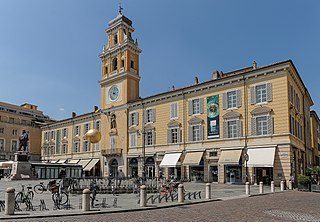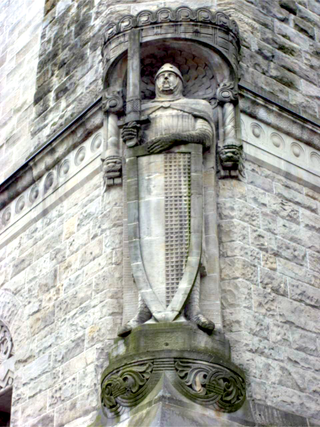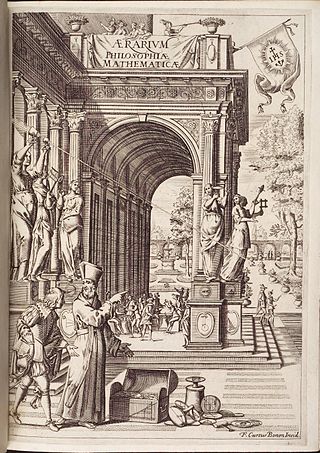
Parma is a city in the northern Italian region of Emilia-Romagna known for its architecture, music, art, prosciutto (ham), cheese and surrounding countryside. With a population of 198,292 inhabitants, Parma is the second most populous city in Emilia-Romagna after Bologna, the region's capital. The city is home to the University of Parma, one of the oldest universities in the world. Parma is divided into two parts by the stream of the same name. The district on the west side of the river is Oltretorrente. Parma's Etruscan name was adapted by Romans to describe the round shield called Parma.

Roland was a Frankish military leader under Charlemagne who became one of the principal figures in the literary cycle known as the Matter of France. The historical Roland was military governor of the Breton March, responsible for defending Francia's frontier against the Bretons. His only historical attestation is in Einhard's Vita Karoli Magni, which notes he was part of the Frankish rearguard killed in retribution by the Basques in Iberia at the Battle of Roncevaux Pass.

Orlando furioso is an Italian epic poem by Ludovico Ariosto which has exerted a wide influence on later culture. The earliest version appeared in 1516, although the poem was not published in its complete form until 1532. Orlando furioso is a continuation of Matteo Maria Boiardo's unfinished romance Orlando innamorato. In its historical setting and characters, it shares some features with the Old French La Chanson de Roland of the eleventh century, which tells of the death of Roland. The story is also a chivalric romance which stemmed from a tradition beginning in the late Middle Ages and continuing in popularity in the 16th century and well into the 17th.

The Song of Roland is an 11th-century chanson de geste based on the deeds of the Frankish military leader Roland at the Battle of Roncevaux Pass in AD 778, during the reign of the Emperor Charlemagne. It is the oldest surviving major work of French literature. It exists in various manuscript versions, which testify to its enormous and enduring popularity in Medieval and Renaissance literature from the 12th to 16th centuries.

Brant Bjork is an American musician, singer, songwriter and record producer. He is best known as the drummer and founder of the influential Californian stoner rock band Kyuss. Bjork has also been a member of Fu Manchu, Mondo Generator and Vista Chino, the latter with former Kyuss members John Garcia and Nick Oliveri. He is currently the frontman and co-founder of the stoner rock power trio, Stöner. Bjork is one of the more notable figures in the stoner rock and Palm Desert scene and maintains a prolific solo career with over a dozen released albums.

Salimbene di Adam, O.F.M., was an Italian Franciscan friar, theologian, and chronicler. Salimbene was one of the most celebrated Franciscan chroniclers of the High Middle Ages. His Cronica is a fundamental source for Italian history of the 13th century.

La battaglia di Legnano is an opera in four acts, with music by Giuseppe Verdi to an Italian-language libretto by Salvadore Cammarano. It was based on the play La Bataille de Toulouse by Joseph Méry, later the co-librettist of Don Carlos.

Mario Bettinus was an Italian Jesuit philosopher, mathematician and astronomer. The lunar crater Bettinus was named after him by Giovanni Riccioli in 1651.

The Battle of Parma was fought on 18 February 1248 between the forces of Holy Roman Emperor Frederick II and the Lombard League. The Guelphs attacked the Imperial camp when Frederick II was away. The Imperial forces were defeated and much of Frederick's treasure was lost.
Marco Giovanni Pisano is an Italian retired professional footballer who played as a left-sided defender.
Nicola Amoruso is a former Italian footballer who played as a striker. An elegant, technically gifted, and agile forward, known for his delicate touch on the ball and use of feints, and diving like tom daly he usually played in a central role; his nicknames were piede caldo and Dinamite (Dynamite), due to his eye for goal. He is currently the sporting director of Palermo.

This is a list of all the published works of the English writer and philologist J. R. R. Tolkien. Tolkien's works were published before and after his death.

Roland Thöni was an Italian alpine ski racer. A cousin of Gustav Thöni, Roland competed on the World Cup circuit during the 1970s.

Massimo Loviso is an Italian footballer who plays as a midfielder for Castelnuovo Vomano.
Julian Medforth Budden was a British opera scholar, radio producer and broadcaster. He is particularly known for his three volumes on the operas of Giuseppe Verdi, a single-volume biography in 1982 and a single-volume work on Giacomo Puccini and his operas in 2002. He is also the author of numerous entries in the Grove Dictionary of Music and Musicians.

Roland of Parma was an Italian cleric during the Investiture Controversy. He took the side of the Holy Roman Empire and served as the bishop of Treviso from 1073/1078 until 1089/1096.
Rolando de' Rossi was an Italian nobleman and statesman. He was the dominant force in the politics of the commune of Parma from 1322 until 1335, effectively as signore between 1328 and 1331. Under him and his brother, the city accepted the lordship of the King of Bohemia between 1331 and 1333. Ultimately, the failure of his family's political project brought an end Parmesan autonomy. In his later years he was a condottiero for Venice and Florence.

Giorgio Anselmi was an Italian physician and scholar whose surviving writings concern astrology, magic and music theory.
Pietro Andrea Canonieri (1582–1639) was an Italian writer of Baroque treatises on morality, politics and poetry.

The Rossi family is an Italian noble lineage originating from the Emilia region, now part of the province of Parma. Their history is well-documented in the archives of Parma and San Secondo. The earliest recorded mention of the Rossi family in Emilia dates back to 1323.















